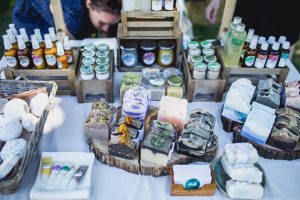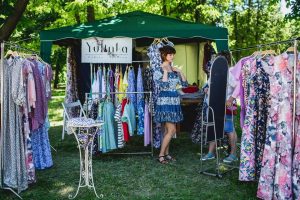After the pro-European Maidan revolution of 2013-2014, the country’s mainstream culture rapidly drifted towards the West, introducing the hipster culture of bars and barber-shops, as well as bringing art into the streets of cities in mass scale. Yet, the revolution also turned Ukrainians to searching own roots, identity, and exploring what their own country had to offer.
And it turned out, Ukraine could offer a lot. Various open-air local businesses’ festivals that regularly take place in different cities bring together hundreds of producers and attract locals and foreigners. Euromaidan Press talked to organizers of two local producers’ festivals about challenges Ukrainian entrepreneurs face and prospects that opened for them thanks to the crisis.
Local goods festivals: How it all begun
In early 2013 then journalist Yuliya Savostina started an experiment: how to survive buying only Ukrainian products. After series of articles, she wrote a book Searching for Made in Ukraine, started a festival of local enterprise Made in Ukraine, and has been assisting local producers in maintaining their businesses in Ukraine.
The festival, Savostina explained in an email comment for Euromaidan Press, started a new fashion for fairs where all locally produced goods could be found. “We taught Ukrainians to buy and try their own goods,” she said adding that people bring their whole families to the fests and never stop wondering how much stuff is being produced in Ukraine.
Ivanna Fedynchuk and Anna Pavliv told in an email about the festival Harmyder that they organize in Lviv. Shortly before launching the first fair in 2014, Ivanna Fedynchuk met Yuriy Lopatynsky, a founder of a social bakery Horihovyi Dim in Lviv. Long discussions led to a symbiotic format: local social enterprise festival. Now Fedynchuk and Pavliv organize Harmyder festival and online auction Buy and Share promoting local producers and donating costs to the local Center of integral help for women in crisis situations.
Harmyder organizers want to teach Ukrainians about a model of social enterprise. If the festival gives a push to at least one social enterprise, they consider it a success, though there are no limits in the goals set.
Ukraine in search for identity
During and right after the revolution of 2013-2014 Ukraine was under the wave of economic patriotism, organizers of festivals comment. Customers realized they could help developing small and local business by buying locally, as well as they started boycotting Russian brands as Kremlin kept expanding its intervention in Ukraine.
Euromaidan made Ukrainians search for their own identity, Savostina stated. That’s why T-shirts and sweatshirts with patriotic symbols like the trident, Ukraine's coat of arms, or ethnic ornaments were a big hit back then: the wave of economic patriotism brought up many new brands, as well as helped refresh the ones that had been in the market for 10-15 years. One could start off as a successful enterprise just by offering popular patriotic assortment, Pavliv said, while now the customer is much more demanding.
According to Savostina, only later Ukrainians became interested in locally produced cosmetics, household chemicals, tableware, clothes, and shoes. At the moment when Savostina was organizing her first Made in Ukraine festival, demand was 3-4 times higher than the supply, she recalled. However, it was still hard to predict which producers to bring to the festival. Interest to local products burst up following all the impetuous events in the country.
Too expensive for locals, not enough standardized for abroad
According to Savostina, economic crisis, and inflation were next factors to push Ukrainians to local goods, however, Ukrainian goods can’t be as cheap as Chinese and Turkish ones.
Beacuse of the crisis, Ukrainian customers first of all follow the price criteria. Big international brands have huge advantages in own production capacities, access to quality materials, and many years’ experience, Harmyder organizers said. All this raises costs of local products which, however, do not always match the prices quality-wise.
Yet, availability of e-commerce tools, as well as little state control over newly emerged enterprises give much hope to Ukrainian businesses, Fedynchuk said. Festivals and fairs serve as perfect platforms for establishing an emotional connection between new brands and customers which will later result in development and recognizability. For instance, one young Lviv family’s hobby of sewing clothes for their pets turned into a successful family business shortly after they participated in Harmyder festival.
Pavliv states that demand for local Ukrainian products stretches even beyond the country: diaspora and friends of Ukraine abroad could be another market. However, meeting the unified European standards is the new challenge.
Compared to Europe, Ukrainian products certainly win, Savostina assured, though we could never compete with giants such as Inditex or H&M. Still, in order to enter big shopping malls, Ukrainian producers need to learn how to work with accordance of world and European retail timing, as well as how to manage strategic planning.
“Even though the wave of economic patriotism goes down, the window of opportunities is still very wide,” - Savostina concluded. “Ukrainians developed the main habit: a habit of buying Ukrainian goods. So if quality, price, and service will win over foreign analogs, people will keep preferring local goods.”






